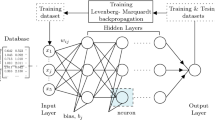Abstract
Computational modeling tools such as molecular dynamics (MD), ab initio, finite element modeling or continuum mechanics models have been extensively applied to study the properties of carbon nanotubes (CNTs) based on given input variables such as temperature, geometry and defects. Artificial intelligence techniques can be used to further complement the application of numerical methods in characterizing the properties of CNTs. In this paper, we have introduced the application of multi-gene genetic programming (MGGP) and support vector regression to formulate the mathematical relationship between the compressive strength of CNTs and input variables such as temperature and diameter. The predictions of compressive strength of CNTs made by these models are compared to those generated using MD simulations. The results indicate that MGGP method can be deployed as a powerful method for predicting the compressive strength of the carbon nanotubes.










Similar content being viewed by others
References
S. Iijima, Nature 354, 56–58 (1991)
L. Deng, S.J. Eichhorn, C.C. Kao, R.J. Young, ACS Appl. Mater. Interfaces 3, 433–440 (2011)
Y. Gao, Y. Bando, Z. Liu, D. Golberg, H. Nakanishi, Appl. Phys. Lett. 83, 2913–2915 (2003)
A. Krishnan, E. Dujardin, T.W. Ebbesen, P.N. Yianilos, M.M.J. Treacy, Phys. Rev. B Condens. Matter Mater. Phys. 58, 14013–14019 (1998)
M.M.J. Treacy, T.W. Ebbesen, J.M. Gibson, Nature 381, 678–680 (1996)
K.M. Liew, C.H. Wong, X.Q. He, M.J. Tan, S.A. Meguid, Phys. Rev. B 69, 115429 (2004)
V. Vijayaraghavan, C.H. Wong, Comput. Mater. Sci. 79, 519–526 (2013)
C.H. Wong, Comput. Mater. Sci. 49, 143–147 (2010)
C.H. Wong, V. Vijayaraghavan, J. Nanomater. 2012, 490872 (2012). doi:10.1155/2012/490872
Y.Y. Zhang, C.M. Wang, V.B.C. Tan, Nanotechnology 20, 215702 (2009)
Y.Y. Zhang, C.M. Wang, Y. Xiang, Carbon 48, 4100–4108 (2010)
S. Iijima, T. Ichihashi, Nature 363, 603–605 (1993)
B. Xu, Z. Shen, X. Ni, J. Wang, J. Guan, J. Lu, Appl. Phys. Lett. 85, 6161–6163 (2004)
G.M. Sacha, F.B. Rodríguez, P. Varona, Nanotechnology 20 (2009). doi:10.1088/0957-4484/20/8/085702
N. Asproulis, D. Drikakis, J. Comput. Theor. Nanosci. 6, 514–518 (2009)
J. Yu, B. Wu, C. He, J. Test. Eval. 36, 103–108 (2008)
J. Yu, B. Wu, NDT E Int. 42, 452–458 (2009)
E. Castellano-Hernández, F.B. Rodríguez, E. Serrano, P. Varona, G.M. Sacha, Nanoscale Res. Lett. 7, 1–12 (2012)
M.A. Al-Khedher, C. Pezeshki, J.L. McHale, F.J. Knorr, Nanotechnology 18 (2007). doi:10.1088/0957-4484/18/35/355703
D.W. Brenner, O.A. Shenderova, J.A. Harrison, S.J. Stuart, B. Ni, S.B. Sinnott, J. Phys. Condens. Matter 14, 783–802 (2002)
W.G. Hoover, Phys. Rev. A 31, 1695–1697 (1985)
S. Nose, J. Chem. Phys. 81, 511–519 (1984)
L. Verlet, Phys. Rev. 159, 98–103 (1967)
J.R. Koza, Genetic programming: on the programming of computers by means of natural selection (MIT Press, Cambridge, 1992)
D.P. Searson, D.E. Leahy, M.J. Willis, Proc. Int. Multiconf. Eng. Computer Sci. 1, 77–80 (2010)
B. Allen, V. Nistor, E. Dutson, G. Carman, C. Lewis, P. Faloutsos, Surg. Endosc. Other Interv. Tech. 24, 170–178 (2010)
A. Mammone, M. Turchi, N. Cristianini, Wiley Interdiscip. Rev. Comput. Stat. 1, 283–289 (2009)
A. Garg, Y. Bhalerao, K. Tai, Int. J. Model. Identif. Control 20, 121–129 (2013)
A. Garg, V. Vijayaraghavan, S.S. Mahapatra, K. Tai, C.H. Wong, Expert Syst. Appl. 41, 1389–1399 (2014)
K. Pelckmans, J.A. Suykens, T. Van Gestel, J. De Brabanter, L. Lukas, B. Hamers, B. De Moor, J. Vandewalle, Tutorial (KULeuven-ESAT, Leuven, 2002)
U. Çaydaş, S. Ekici, J. Intell. Manuf. 23, 639–650 (2012)
V. Cherkassky, Y. Ma, Neural Comput. 15, 1691–1714 (2003)
Author information
Authors and Affiliations
Corresponding author
Rights and permissions
About this article
Cite this article
Vijayaraghavan, V., Garg, A., Wong, C.H. et al. Estimation of mechanical properties of nanomaterials using artificial intelligence methods. Appl. Phys. A 116, 1099–1107 (2014). https://doi.org/10.1007/s00339-013-8192-3
Received:
Accepted:
Published:
Issue Date:
DOI: https://doi.org/10.1007/s00339-013-8192-3




